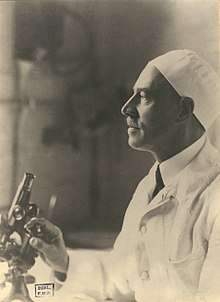Paul-Félix Armand-Delille
Paul-Félix Armand-Delille (3 July 1874 in Fourchambault, Nièvre – 4 September 1963) was a physician, bacteriologist, professor, and member of the French Academy of Medicine who accidentally brought about the collapse of rabbit populations throughout much of Europe and beyond in the 1950s by infecting them with myxomatosis.
| Paul-Félix Armand-Delille | |
|---|---|
 Paul-Félix Armand-Delille | |
| Born | 3 July 1874 Fourchambault |
| Died | 4 September 1963 Maillebois |
| Occupation | Physician |
Biography
Born in Fourchambault in Central France, Armand-Delille studied medicine and became a professor at the Paris School of Medicine, specialising in infectious diseases in children. During the First World War he carried out important work on malaria, for which he was made a Commander of the Legion of Honour.
Myxomatosis release
It was during his retirement that the events for which he became best known took place. Having read of the effectiveness of the myxomatosis virus in dealing with rabbit plagues in Australia, in 1952 Armand-Delille decided to introduce the virus onto his 3 km² private estate of Chateau Maillebois in Eure-et-Loir. He believed that the enclosed nature of the estate would prevent its spread. Inoculating two rabbits with virus acquired from a laboratory in Lausanne, Armand-Delille succeeded in rapidly eradicating the population on his estate, with 98% of the rabbits being dead within 6 weeks. However, within 4 months it became clear that the virus had escaped from his estate, the corpse of an infected rabbit having been found 50 km away.[1][2]
Within a year of the initial release, an estimated 45% of the wild rabbits of France had died of the disease, along with 35% of domestic rabbits, and the disease had spread to the rest of western Europe, destroying rabbit populations in the Netherlands, Belgium, Italy, Spain, Britain, and beyond. The effect on the rabbit population of France was dramatic. In the hunting season covering the year of the release of the virus, 1952–53, the total number of rabbits killed in 25 hunts exceeded 55 million. The figure for 1956-57 was just 1.3 million, a 98% reduction.
Armand-Delille found himself both condemned by rabbit hunters and showered with praise by farmers and foresters. He was prosecuted, and in January 1955 he was convicted and fined 5,000 francs. However, he was later honored; in June 1956 he was awarded a gold medal to commemorate his achievement by Bernard Dufay, honorary director-general of the French Department of Rivers and Forests. The medal depicts Armand-Delille on one side, and a dead rabbit on the other.
The disease has affected predators dependent on rabbits, in particular the Iberian lynx, a rabbit specialist which is unable to significantly adapt its diet. It is not uncommon for shooters to specifically target infected rabbits, viewing the act as being merciful. However, in 2005 the UK Land Registry conducted a survey of 16,000 hectares of its land and reported that the rabbit population had increased three-fold every two years - likely a product of increasing genetic resistance to the virus.
Bibliography
- The Private Life of the Rabbit by R. M. Lockley (Andre Deutsch, London 1964)
- International Herald Tribune, Wednesday, June 7, 2006, page 2.
References
- The Bird of Time: The Science and Politics of Nature Conservation ... N. W. Moore - 1987- Page 123 "Also, numerous wild species benefited greatly since the vegetation recovered and competition from rabbits virtually disappeared. In June 1952 Dr Armand Delille, a French doctor, introduced the myxoma virus onto his estate near Paris."
- Peter C. Doherty Pandemics: What Everyone Needs to Know - 2012 Page 161 "Wanting to control the wild rabbits on his property, retired French bacteriologist and academician Paul Armand-Delille got hold of some myxomavirus and injected two rabbits, which he then released at Chateau Maillebois in the Loire Valley."